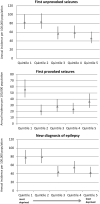Association between social deprivation and incidence of first seizures and epilepsy: A prospective population-based cohort
- PMID: 35611982
- PMCID: PMC9544186
- DOI: 10.1111/epi.17313
Association between social deprivation and incidence of first seizures and epilepsy: A prospective population-based cohort
Abstract
Objective: Epidemiologic studies have investigated whether social deprivation is associated with a higher incidence of epilepsy, and results are conflicting, especially in children. The mechanisms underlying a potential association are unclear. This study examines whether there is an association between social deprivation and the incidence of first seizures (unprovoked and provoked) and new diagnosis of epilepsy by comparing incidence across an area-level measure of deprivation in a population-based cohort.
Methods: Multiple methods of case identification followed by individual case validation and classification were carried out in a defined geographical area (population 542 868) to identify all incident cases of first provoked and first unprovoked seizures and new diagnosis of epilepsy presenting during the calendar year 2017. An area-level relative deprivation index, based on 10 indicators from census data, was assigned to each patient according to registered address and categorized into quintiles from most to least deprived.
Results: The annual incidence of first unprovoked seizures (n = 372), first provoked seizures (n = 189), and new diagnosis of epilepsy (n = 336) was highest in the most deprived areas compared to the least deprived areas (incidence ratios of 1.79 [95% confidence interval (CI) = 1.26-2.52], 1.55 [95% CI = 1.04-2.32], and 1.83 [95% CI = 1.28-2.62], respectively). This finding was evident in both adults and children and in those with structural and unknown etiologies of epilepsy.
Significance: The incidence of first seizures and new diagnosis of epilepsy is associated with more social deprivation. The reason for this higher incidence is likely multifactorial.
Keywords: epilepsy; incidence; seizures; social deprivation.
© 2022 The Authors. Epilepsia published by Wiley Periodicals LLC on behalf of International League Against Epilepsy.
Conflict of interest statement
None of the authors has any conflict of interest to disclose. We confirm that we have read the Journal's position on issues involved in ethical publication and affirm that this report is consistent with those guidelines.
Figures
Similar articles
-
Causes and classification of first unprovoked seizures and newly-diagnosed epilepsy in a defined geographical area- an all-comers analysis.Seizure. 2021 Nov;92:118-127. doi: 10.1016/j.seizure.2021.08.016. Epub 2021 Aug 28. Seizure. 2021. PMID: 34508947
-
Application of Recent International Epidemiological Guidelines to a Prospective Study of the Incidence of First Seizures, Newly-Diagnosed Epilepsy and Seizure Mimics in a Defined Geographic Region in Ireland.Neuroepidemiology. 2019;53(3-4):225-236. doi: 10.1159/000502009. Epub 2019 Aug 21. Neuroepidemiology. 2019. PMID: 31434084
-
Risk of epilepsy following first unprovoked and acute seizures: Cohort study.Epilepsia. 2025 Apr;66(4):1223-1233. doi: 10.1111/epi.18276. Epub 2025 Feb 3. Epilepsia. 2025. PMID: 39898778 Free PMC article.
-
Seizures in children.Pediatr Clin North Am. 2006 Apr;53(2):257-77. doi: 10.1016/j.pcl.2005.09.010. Pediatr Clin North Am. 2006. PMID: 16574525 Review.
-
When to start drug treatment for childhood epilepsy: the clinical-epidemiological evidence.Eur J Paediatr Neurol. 2009 Mar;13(2):93-101. doi: 10.1016/j.ejpn.2008.02.010. Epub 2008 Jun 24. Eur J Paediatr Neurol. 2009. PMID: 18567515 Review.
Cited by
-
Validation of targeted next-generation sequencing panels in a cohort of Polish patients with epilepsy: assessing variable performance across clinical endophenotypes and uncovering novel genetic variants.Front Neurol. 2024 Jan 12;14:1316933. doi: 10.3389/fneur.2023.1316933. eCollection 2023. Front Neurol. 2024. PMID: 38328757 Free PMC article.
-
Cognitive and brain health in juvenile myoclonic epilepsy: Role of social determinants of health.Epilepsia. 2025 May;66(5):1641-1651. doi: 10.1111/epi.18296. Epub 2025 Feb 17. Epilepsia. 2025. PMID: 39963015 Free PMC article.
-
Impact of sociodemographic disadvantage on neurobehavioral outcomes in children with newly diagnosed seizures and their unaffected siblings over 36 months.Epilepsia. 2023 Aug;64(8):2172-2185. doi: 10.1111/epi.17672. Epub 2023 Jun 15. Epilepsia. 2023. PMID: 37264778 Free PMC article.
-
Association of Neighborhood Deprivation With Cognitive and Mood Outcomes in Adults With Pharmacoresistant Temporal Lobe Epilepsy.Neurology. 2023 Jun 6;100(23):e2350-e2359. doi: 10.1212/WNL.0000000000207266. Epub 2023 Apr 19. Neurology. 2023. PMID: 37076308 Free PMC article.
-
Association of neighborhood deprivation with white matter connectome abnormalities in temporal lobe epilepsy.Epilepsia. 2023 Sep;64(9):2484-2498. doi: 10.1111/epi.17702. Epub 2023 Jul 11. Epilepsia. 2023. PMID: 37376741 Free PMC article.
References
-
- Magnusson C. High‐resolution mapping of epilepsy prevalence, ambulance use, and socioeconomic deprivation in an urban area of Sweden. Epilepsia. 2019;60(10):2060–7. - PubMed
-
- Pickrell WO, Lacey AS, Bodger OG, Demmler JC, Thomas RH, Lyons RA, et al. Epilepsy and deprivation, a data linkage study. Epilepsia. 2015;56(4):585–91. - PubMed


